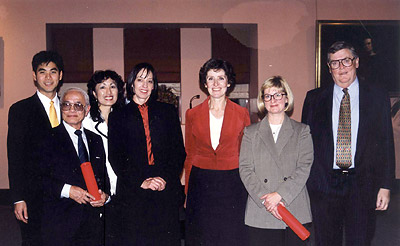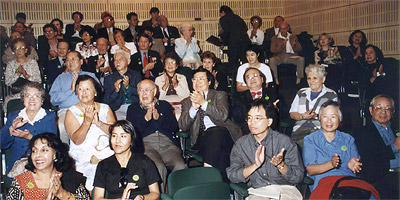Community history, ChinesePost-War Chinese Australians project
|
| View the Post-War Chinese Australian contributors |
Post-War Chinese Australians is a collection of life stories and community histories told through oral history recorded by Diana Giese. The old families of Chinese Australia have lived and worked in this country for up to six generations. Many of the descendants of Chinese pioneers who came here to seek their fortunes on the goldfields or to start market gardens, stores or services, have now spoken on tape as part of the project, begun in 1992. They have been joined by first-generation migrants from Hong Kong, Singapore, Malaysia and China itself, by those who came here from the 1960s for education, and by people who originally arrived with nothing, as refugees. There are stories of courage, risk-taking and entrepreneurial flair; of the prejudices of White Australia overcome by hard work and persistence; of quiet achievement and flamboyant success; and the rich and ancient cultural traditions that make many proud Australians also keen to acknowledge their Chinese roots…
 |
|
| Stephen Leong, Hamilton Chan, Rosalie Hiah, future Director-General of the National Library of Australia, Jan Fullerton, Diana Giese, Pam Gatenby and then-Director-General Warren Horton at the launch of the Chinese Australian Oral History Partnership. |
Each interview has added fine detail to the big picture of Chinese Australian experiences in this country, indicating their complexity and diversity. Strong inter-relationships and networks have been built up between the Library and communities country-wide. Cairns marine biologist, collaborator and interviewee Warren Lee Long says that: People are now swapping information, ideas and material. Diana has pulled them together, from across a large country, to stir up reclamation of our Chinese past. This is leading to exposure and recognition of things in Australia’s recent history which have been left up until now hidden under the bed, in boxes in the garage, or remained quiet in the minds of our elders.’
(from ‘Chinese Australian Oral History Partnerships’, National Library of Australia News, July 1998)
See Papers of Diana Giese at https://nla.gov.au/nla.obj-341276786 |
|
| Chinese community event at the Museum of Sydney. (Courtesy Lionel Nomchong) |
Through interviews and related activities around the country, these projects, co-ordinated by Diana Giese, provide an overview of the diverse Chinese Australian community. The lives and times of dozens of people have been recorded. There are community elder statesmen (such as Charles See-Kee in Darwin, Eddie Liu in Brisbane, Bishop George Tung Yep in Cairns and Bo Liu in Sydney); leaders (such as members of Parliament of Chinese background, Dr John Yu, 1996 Australian of the Year and then-NSW Ombudsman Irene Moss); pioneers (such as 90-year-old Dora See Poy in Innisfail); young achievers (such as artists Ah Xian, Zhou Xiaoping and Shen Jiawei and media personality Annette Shun Wah); and migrant success stories (such as Dr Moni Lai Storz from Malaysia and Tac Tam Lam from Vietnam).
The project has highlighted the interconnections between communities over time, through clan links, business ties and intermarriage, across Australia from Darwin to Melbourne, Cairns to Sydney, and back to the ancestral homeland itself. It has emphasised the continuing importance of clans and families, and interviews include several generations of some families (such as the See Poys, Lee Longs and Tongs in Cairns), and the descendants of some distinguished pioneers (such as Yuen Yet Hing’s in Darwin). It also takes in those who have married into extended Chinese families (such as Paul Campbell and Jacqui Tong). Informants have, through descriptions of their own lives, personal, professional and community achievements, helped restore Chinese contributions to Australia’s development to the mainstream historical record. Digital tapes are preserved and catalogued by the Library, and verbatim transcripts, written versions, made available to researchers. Via databases accessed online, the tapes, transcripts and summaries are available through libraries country-wide.
